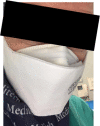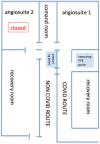How to Handle a COVID-19 Patient in the Angiographic Suite
- PMID: 32277272
- PMCID: PMC7147145
- DOI: 10.1007/s00270-020-02476-8
How to Handle a COVID-19 Patient in the Angiographic Suite
Abstract
This is a single-center report on coordination of staff and handling of patients during the outbreak of the COVID-19 (coronavirus disease 2019) in a region with high incidence and prevalence of disease. The selection of procedures for interventional radiology (IR), preparation of staff and interventional suite before the arrival of patients, the facility ventilation systems and intra- and post-procedural workflow optimization are described. The control measures described may increase the cost of the equipment, prolong procedural times and increase technical difficulties. However, these precautions may help control the spread of COVID-19 within the healthcare facility.
Keywords: Angiosuite; COVID-19; Coronavirus disease 2019; Interventional radiology.
Conflict of interest statement
Authors declare that they have no conflict of interest.
Figures




References
-
- https://www.who.int/emergencies/diseases/novel-coronavirus-2019/situatio.... Accessed on 18 March 2020, at 179.
-
- Rational use of personal protective equipment for coronavirus disease 2019 (COVID-19): interim guidance; 27 February 2020, World health Organization. https://apps.who.int/iris/bitstream/handle/10665/331215/WHO-2019-nCov-IP....

